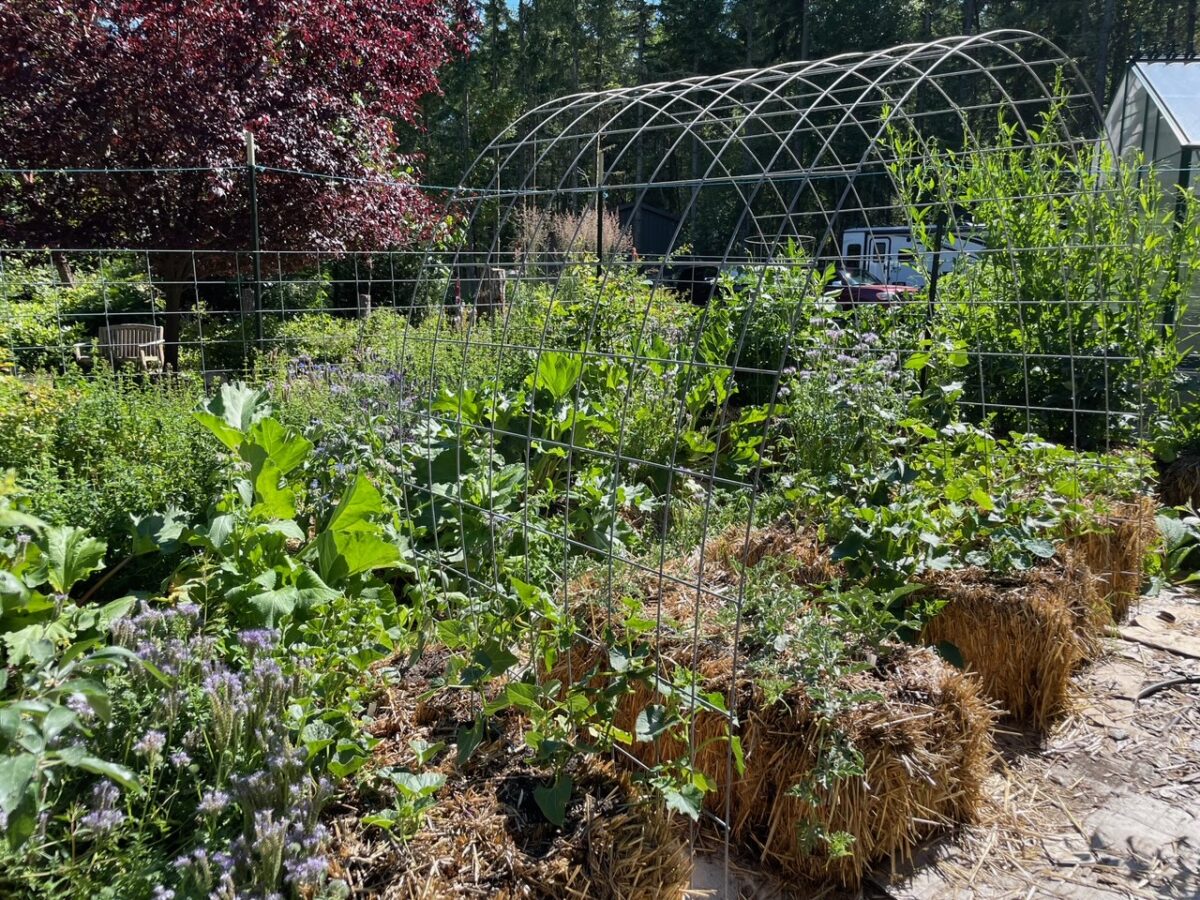by Barbara Faurot • For generations, straw bales have been used to grow a steady supply of fresh vegetables, fruits,
and flowers. Like other traditional gardening practices, they’re enjoying a resurgence as gardeners discover their benefits —even in limited spaces or less-than-ideal soil conditions.
Placed directly on the ground, the bales form raised beds, making them easy to care for. Straw bale gardening typically has fewer pests, diseases, and weeds compared to growing directly in the soil. The bales protect roots from cold temperatures and help conserve water. Research also demonstrates that crop yield is increased compared to soil-grown vegetables. At the end of the season, the decomposed bales provide compost as a by-product.
Julia Cordz, WSU Jefferson County Master Gardener, experiments with straw bales in her garden to address issues like glacial till and large tree roots. “It’s just so convenient, and it works fabulously,” says Julia. “I can put the bales where there’s enough sun and a water spigot, without digging into poor, compacted soil or disturbing tree roots.”
Julia adds that straw bales can be an economical alternative to purchasing large amounts of potting soil or other growing media. Locally, a large 4’ x 2’ bale might sell for $12-15. Smaller bales are also available.
It’s important to use straw, not hay. Straw includes cereal stalks after the grain has been harvested. Hay is pasture grass grown for livestock feed, and will include seed heads and other weed seeds. Tightly baled straw from any cereal crop like wheat, barley, rye, or oats can be used.
Julia prefers purchasing from known local sources, such as farm and seed stores, who offer bales from locally grown grains. For example, the Co-Op Farm & Garden in Sequim offers bales made by Graysmarsh Farm. Gardeners can even make their own bales from soft herbaceous material like grass clippings and decomposed leaves, compressed into bales and bound with
string or wire.
A variety of plants can be grown in straw bales. Tomatoes, cucumbers, lettuce, peppers, melons, and squashes are just a few examples. Culinary herbs and flowers are also good choices. Shallow bulb crops like garlic or leeks grow well planted in one-year-old bales.
With some crops, Julia uses a trellis to direct growth upward and create airflow around the plants. “Suppress the urge to place plants too close together,” advises Julia. She found that larger crops like brussels sprouts and kale grow too large and are better planted in the ground.
Mid-March is a good time to begin the process. Keep the bales dry until they are in their desired location. Place them on any flat surface, directly on the soil, or partially buried. To suppress weeds and deter rodents, Julia starts with a layer of ¼-inch hardware cloth, then adds layers of cardboard and coarse wood chip mulch before setting the bale on top. Add mulch around the base to further discourage weeds.
Prior to planting, bales need to be “conditioned” for a few weeks, creating an environment for beneficial fungi, insects, and bacteria to begin breaking down the straw to make nutrients available to young plant roots. This involves soaking the bales with water and keeping them wet, but not water-logged. As the inside of the bales begins to decompose, the temperature rises.
You’ll add a nitrogen-rich fertilizer to help balance the high carbon to nitrogen ratio and speed up decomposition. Apply fertilizer, typically on days 1, 3, 5, 7, 8, 9, and 10. Julia finds that urea fertilizer works well to get started for the first several days of conditioning. She then shifts to an organic liquid fertilizer. During the first 10 days of the conditioning process, water daily with about a gallon per bale per day.
Once the bales are cool to the touch, with the internal temperature about 90°F, they are ready to plant. The total conditioning process should take about two to three weeks. For small transplants, dig shallow holes into the bale and plant as normal. To plant seeds, place a thin layer of rich organic matter on top of the bales to help them get established without restricting growth of roots into the bale itself.
As with other planting methods, air circulation, consistent watering, and fertilizing are key. Keep the bales moist — don’t let them dry out, but don’t over-water. A soaker hose, drip line, or gallon jug are all good methods. Through the growing season, the straw itself will not provide enough nutrients for plant growth, so Julia recommends applying a balanced organic water-soluble fertilizer on a weekly basis.
The pitfalls of straw bale gardening are similar to planting in other containers or garden beds. Resist the urge to overwater or over-fertilize. Anticipate plant growth and leave plenty of room between plants for sunlight and airflow. Julia found that getting started involves some trial and error, advising “experiment to find what works best in your garden.”
At the end of the growing season, the bales can be broken down and recycled as mulch or added to compost. “Let nature do the composting,” says Julia. The material already contains beneficial bacteria and fungi to feed your soil for your next gardening season.
After two seasons, beneath the decomposed straw, Julia found some magic: the glacial till was transformed into fluffy “black gold” soil, perfect for fruit trees or other plantings. For a free Extension publication about straw bale gardening, visit anrcatalog.ucanr.edu/pdf/8559.pdf.
The Master Gardener Plant Sale will be Saturday, May 4, from 9 a.m.-1 p.m. at Chimacum School’s Multipurpose Room. Master Gardeners and Food Bank Growers will be offering a wide variety of garden vegetables to plant in your straw bales, containers, or in the ground. Young trees, shrubs, and colorful annuals and perennials will also be offered.
Barbara Faurot is a Jefferson County Master Gardener and Master Pruner, working with other volunteers who serve as community educators in gardening and environmental stewardship.
First published in the Port Townsend Leader, March 13, 2024. Photo credit Julia Cordz


